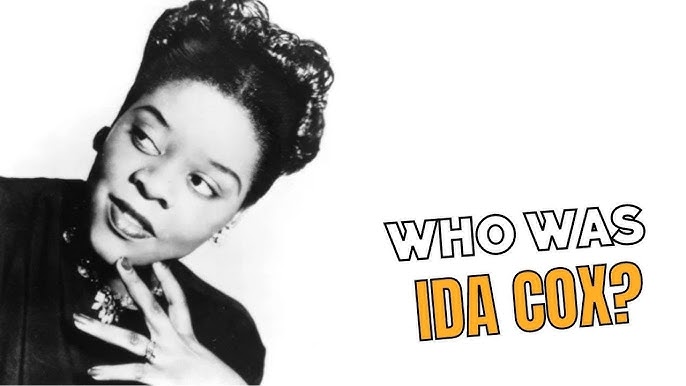Ida Cox – A Complete Biography
Introduction
Ida Cox (born Ida Prather) was one of the defining voices of the classic female-blues era of the 1920s. Marketed as the “Uncrowned Queen of the Blues,” she recorded extensively for Paramount, toured the Theater Owners Booking Association (TOBA) circuit, led her own tent shows, and wrote a striking number of her own songs—rare for women blues singers of the time. Even her basic biographical facts reflect the difficulties of documenting Black performers of her generation: reputable sources list different birth years (1888, 1894, or 1896), but all agree on her death in Knoxville, Tennessee, on November 10, 1967. Her signature number, “Wild Women Don’t Have the Blues,” has since become a feminist anthem, and her late-career comeback album with Coleman Hawkins confirmed her enduring stature.

Childhood
Cox was born Ida M. Prather in Toccoa, Georgia, and grew up in Cedartown. She sang in church as a child and, like many Southern Black performers of her era, learned stage craft early. Accounts disagree on the exact year of her birth, but Georgia sources place it in the mid-1890s, and most biographical entries situate her childhood squarely in North Georgia.
Youth
As a teenager, Cox left home to tour with traveling minstrel and vaudeville companies on the TOBA circuit, including outfits that later became famous launching pads for blues stars. This itinerant education taught her comedy timing, stage presence, and how to front a show—skills she would leverage throughout the 1920s. She also married a cornetist, Attler (or Adler) Cox, during these years; the surname she kept professionally for life.
Adulthood
By 1923, Paramount’s “race records” division brought Cox into its roster. Between 1923 and 1929 she cut dozens of sides—supported frequently by pianist-bandleader Lovie Austin—while Paramount’s publicity crowned her the “Uncrowned Queen of the Blues.”
Cox was not only a headliner; she was a bandleader and entrepreneur. In 1929 she and pianist-songwriter Jesse “Tiny” Crump (whom she married in 1927) launched the tent-show revue Raisin’ Cain (later Darktown Scandals), which toured the South and Midwest through the Depression—an unusual level of ownership and control for a Black woman in show business at the time. Some accounts even credit Raisin’ Cain with being the first TOBA-affiliated show to open at the Apollo Theater that year.
Her profile broadened in 1939 when John Hammond brought her to Carnegie Hall for the celebrated From Spirituals to Swing concerts. There she performed alongside a who’s-who of swing and blues players, and the exposure helped lead to late-1930s/early-1940s recordings for Vocalion and OKeh with all-star sidemen including Charlie Christian and Lionel Hampton.
Major Compositions
Cox stands out among her peers for the number of songs she authored or co-authored, often with lyrics that center women’s autonomy and plain-spoken realism:
- “Wild Women Don’t Have the Blues” (1924). Widely credited to Cox and cut with Lovie Austin’s Blues Serenaders for Paramount; it later became a standard recorded by many artists and is frequently cited as an early feminist statement.
- “Death Letter Blues.” Cox recorded the song in the mid-1940s with her All-Star Orchestra.
- “Mojo Hand Blues.” A collaboration with Jesse Crump from her Paramount years, emblematic of her penchant for vivid, image-rich blues language.
- “Graveyard Dream Blues.” Among her earliest Paramount releases (1923).
- Other notable titles include “Chicago Bound Blues,” “Bama Bound Blues,” and “’Fore Day Creep,” illustrating both her mobility-themed lyrics and her durable working partnership with Lovie Austin and Jesse Crump.
Beyond specific titles, Cox wrote a striking share of her repertoire herself—unusual in a period when many singers were handed material by publishers.
Death and Late Years
Cox’s performing career ended abruptly when she suffered a stroke onstage in Buffalo on April 12, 1945; she retired to Knoxville to live with her daughter and largely limited her singing to church. In 1961, producer Chris Albertson coaxed her into a final session for Riverside—Blues for Rampart Street, backed by Coleman Hawkins, Roy Eldridge, Sammy Price, Milt Hinton, and Jo Jones—an eloquent coda to a storied career. Cox died in Knoxville on November 10, 1967.
Conclusion
Ida Cox’s life traces the arc of early twentieth-century Black show business: from tent shows and TOBA theaters to Paramount studios, Carnegie Hall, and a dignified final statement in the 1960s blues revival. She was a formidable singer, a working bandleader, and—crucially—a songwriter whose words gave voice to a self-possessed female perspective in the blues. Whether dated 1888, 1894, or 1896, her birth preceded a career that helped define a genre and left standards still sung today.

Comments are closed